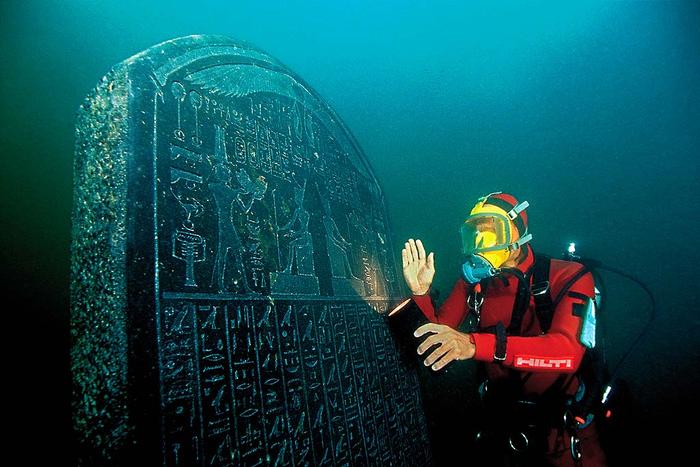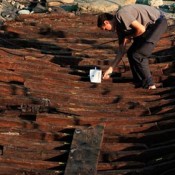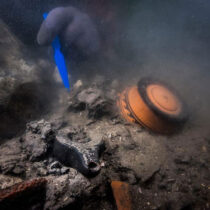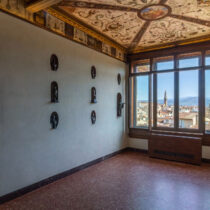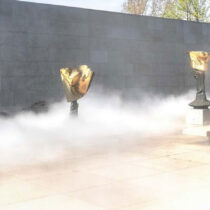New research into , a sunken port-city that served as the gateway to Egypt in the first millennium BC, was examined at an international conference at the University of Oxford.
The port-city known as ‘Thonis’ by the Egyptians and ‘Heracleion’ by the Greeks, was was one of the biggest commercial hubs in the Mediterranean before the founding of Alexandria. Situated 6.5 klm. off today’s coastline in the western part of today’s Abu-Qir Bay, it offered the perfect spot for seagoing ships to unload their cargoes for tax-extracting as well as assessment by temple officials, before transferring them to Egyptian ships that went upriver.The city was founded probably around the 8th century BC, underwent diverse natural catastrophes, and finally sunk entirely into the depths of the Mediterranean in the 8th century AD.
In the ports of the city, divers and researchers are currently trying to solve the mystery of 64 Egyptian ships, many of which appear to have been deliberately sunk. According to researchers, the ships, dating between the 8th and 2nd centuries BC, were found beautifully preserved in the mud of the sea-bed. With 700 examples of different types of ancient anchor, this represents the largest nautical collection from the ancient world.
‘The survey has revealed an enormous submerged landscape with the remains of at least two major ancient settlements within a part of the Nile delta that was crisscrossed with natural and artificial waterways,’ said Dr Damian Robinson, Director of the Oxford Centre for Maritime Archaeology (OCMA) at the University of Oxford. Dr Robinson and his team are excavating a submerged ship known as Ship 43, examining why the boats appear to have been deliberately sunk close to the port. Up to now, he has discovered that the Egyptians had a unique shipbuilding style.
‘One of the key questions is why several ship graveyards were created about one mile from the mouth of the River Nile. Ship 43 appears to be part of a large cluster of at least ten other vessels in a large ship graveyard,’ explained Dr Robinson. ‘This might not have been simple abandonment, but a means of blocking enemy ships from gaining entrance to the port-city. Seductive as this interpretation is, however, we must also consider whether these boats were sunk simply to use them for land reclamation purposes.’
A collection of customs decrees, trading weights, and evidence of coin production have also been found during research at the port and its harbour. Such elements of material culture were discussed at the conference, in order to figure out how maritime trade worked in the ancient world.
Elsbeth van der Wilt, from the University of Oxford,explains: ‘Thonis-Heracleion played an important role in the network of long-distance trade in the Eastern Mediterranean, since the city would have been the first stop for foreign merchants at the Egyptian border. Excavations in the harbour basins yielded an interesting group of lead weights, likely to have been used by both temple officials and merchants in the payment of taxes and the purchasing of goods. Amongst these are an important group of Athenian weights. They are a significant archaeological find because it is the first time that weights like these have been identified during excavations in Egypt.’
Another Oxford researcher, Sanda Heinz, is analysing more than 300 statuettes and amulets from the Late and Ptolemaic Periods, including Egyptian and Greek subjects. The majority depict Egyptian deities such as Osiris, Isis, and their son Horus. ‘The statuettes and amulets are generally in excellent condition […]. (They) allow us to examine their belief system and at the same time have wider economic implications. These figures were mass-produced at a scale hitherto unmatched in previous periods. Our findings suggest they were made primarily for Egyptians; however, there is evidence to show that some foreigners also bought them and dedicated them in temples abroad.’
On this project, the OCMA is collaborating with the European Institute for Underwater Archaeology (IEASM) in cooperation with Egypt’s Ministry of State for Antiquities. Franck Goddio, Director of the IEASM and Visiting Senior Lecturer in Maritime Archaeology at the OCMA, commented: ‘The discoveries we have made in Thonis-Heracleion since 2000 thanks to the work of a multidisciplinary team and the support of the Hilti Foundation are encouraging. Charts of the city’s monuments, ports and channels are taking shape more clearly and further crucial information is gathered each year.’
